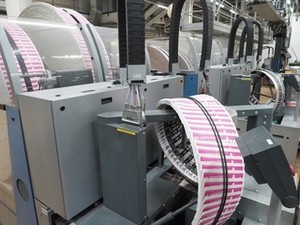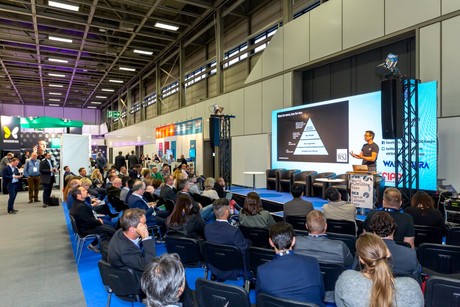CEO Markus Brehm, technical manager Wilfried Sutter and production manager Bastian Korbel share the view that a mailroom often stays in service for much longer than a printing press. They consider 20 years as quite par for the course and were mindful of this in 2014, when first thoughts were given to replacing the existing Ferag mailroom.
The configuration then operating had been installed in 1998 along with two KBA Express presses, printing technology that was superseded in 2013 by a new Manroland Colorman e:line. While this has nominally four printing towers and two folders, Allgäuer Zeitungsverlag always treated it as a single 48-page press with one folder output; the other two towers and folder were there simply as backups.
Reducing the printing machinery to just this one line was not without risk: the figure of 105,000 copies coming out of Allgäuer Zeitungsverlag at the time clearly exceeded the customary limit for a single line (approx. 80,000 copies). Yet this arrangement had worked well so far, producing the print run on schedule within four hours, six nights a week. Thus it might be expected that discussion about the latest mailroom investment would quickly focus on reducing from two production lines to one.
A helpful coincidence
It came down to coincidence that the invitation to tender for new mailroom technology ultimately became moot. Whereas, for example, the existing MTD winding machinery from 1998 had always been earmarked for retrofitting and continued use thereafter, the publishing company sought in any event to replace the SNT-U trimming drum with a used machine of the same type. Among the items offered to Allgäuer Zeitungsverlag was an SNT-U from Zehnder Print AG in Rickenbach, Switzerland, which became available when the company’s newspaper printing operation there closed down in mid-2016.
Markus Brehm and his team quickly realized that there was much more to be had from Zehnder – namely, a complete mailroom that had been operating only since 2011/2012 and was just partially utilized during its few years in service. With the help of a consultant from Germany and partner Ferag, who of course was very familiar with the technology in Rickenbach, Allgäuer Zeitungsverlag developed a completely new concept. It was about combining retrofit modules from the Kempten inventory with the virtually complete Zehnder mailroom, and supplementing it all with technology from the current Ferag portfolio.
Retrofit comes first
Controllers for the MTD units had already been brought up to date in March 2017 as a first step, so they were compatible with the current IT. In May, the first of the existing finishing lines at Allgäuer Zeitungsverlag was dismantled in order to make space for setting up the machinery from Zehnder, certain components of which had earlier been checked and overhauled in Hinwil. For production in Kempten, however, the dismantling meant having to make do with just one of the two 19-year-old lines between May and September. This was only possible by moving forward the start of the print run to 7.30 pm during the transition.
The central component of the system that was relocated to Kempten is an RSD RollSertDrum with – at the final count – twelve feeders for insert products. For space reasons it was only possible to install eight initially, especially since Allgäuer Zeitungsverlag wanted the JetFeeder hoppers positioned more widely apart in order to streamline the supply of pallets laden with inserts. The new mailroom began operation in September 2017, whereupon the second old finishing line could finally be closed down and dismantled. The RollSert system now has four hoppers supplied automatically from reels, and eight hoppers where stacks of inserts can be loaded manually.
Allgäuer Zeitungsverlag produces offline only, meaning that all products from the printing press are first buffered on MTD winding technology. This makes it possible to achieve optimum production speeds in both printing and finishing. In order to be safe and certain even with just one inserting and finishing line, an unwinding station was put together out of modules taken from existing inventory. Via a stack pacer, it can accumulate bundles for intermediate storage if necessary. Like this it is always possible to ship out the daily newspaper – albeit without inserts and preprinted products.
Navigator brought up-to-date
The bundling area has been upgraded to three compensating stackers thanks to a new MultiStack plus SmartStrap strapping system, while evacuation is via a newly acquired Ferag bundle dispatch system. Parts of the UTR Universal Conveyor are new as well. Navigator was also part of the package from Rickenbach. With Ferag having updated the Navigator software, the mailroom control system at Allgäuer Zeitungsverlag has leapt from the 1980s directly to 2017 – in the words of production manager Bastian Korbel.
Allgäuer Zeitungsverlag is very satisfied with Ferag’s project support, which demonstrated in particular a capability to mix and match very different generations of technology and make everything compatible.
Considering that most of the mailroom technology invested in is five to six years old, Allgäuer Zeitungsverlag now anticipates that both the printing and finishing machinery will reach end-of-life together, probably by the late 2020s. So it will be around 2025/2026 when thoughts turn to future means of production. But at present, notes CEO Markus Brehm, the company “is doing very well from printed daily newspapers”.
Interview with Bastian Korbel, production manager:
https://www.ferag.com/en/3644/Gazing-far-into-the-future.htm?Article=30597
Allgäuer Zeitungsverlag: Gazing far into the future – with Ferag
Allgäuer Zeitungsverlag: Gazing far into the future – with Ferag
Article ID:
21691
08.02.2018 – Allgäuer Zeitungsverlag GmbH in Kempten (Germany) is the kind of company that operates with a very long term view. Any investment here is considered not only in light of its full working lifecycle, but also with an eye to what comes thereafter. It was against this backdrop that a new mailroom was commissioned in the autumn of 2017, combining used Ferag components dating from 1998 and 2011 with the latest technology from Hinwil. One aim of this complex project has been to “synchronize” the anticipated working lives of the press and finishing lines.

Mailroom of the Allgäuer Zeitungsverlag (photo source: Ferag).
Related Articles
-
2020-10-15 11:21
-
2020-10-08 10:36
-
2020-09-29 17:42
-
2020-09-29 17:24
-
2020-09-29 10:57




